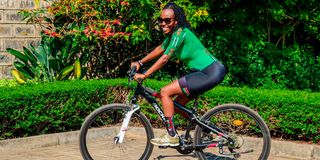For three years now, the roads have been calling Wendy Sigey. When not on her BTWIN Triban 500 road bicycle, she is a lawyer.
The mother of one is an ebullient fun lover. On her saddle, she is a curious adventure seeker. It gives her a certain high.
A hobby the 28-year-old picked at the height of the Covid-19 pandemic, it has grown into a fun obsession.
The last three years have been defined by long rides that take days at a time. Wendy is the queen of the hobby of long-distance cycling, and the saddle is her throne. For context, she has cycled to Malindi once (630 kilometres), and twice to Moshi, Tanzania.
At the time of this interview, she and her team were planning to cycle to Diani at the Coastal region. For many people, like Wendy, this kind of cycling is akin to a high-wire act.
“First, you choose cycling, and then cycling keeps choosing you. Even on days you don’t feel like hitting the road, your body and mind demand that you gear up and pursue this adventure,” she says.
It is a hunger that knows no satiation—a delicate equilibrium to maintain.
“Having this active life on the road and attending to other young adulthood priorities is challenging. I am a young woman with a fun life to live and friends to go out with. I have had to be very intentional about how I spend my time to achieve wholesomeness.”
Wendy makes two key preparations before she sets out. One for the road and one for her life outside cycling.
Cyclist Wendy Sigey during an interview in Nairobi on August 6, 2024.
Photo credit: BONFACE BOGITA | NATION
“I prepare myself mentally first, you win on the road when your mind is well prepared. For physical preparations, I take shorter rides many days and even months to the longer rides. I maintain the right diet for the intense activity ahead, ” she says.
To achieve this, she does a lot of carb-loading to optimise her endurance on the road. Lastly, she services her bicycle, packs up spares and tools in case she needs them on the road, and gets the right gear, both in quality and quantity.
“With the road taken care of, I plan for the time I will be absent from home. As a mother, these plans are key in affording me peace of mind while on the road. It helps to plan about school, meals, sporting activities, health, among others. Being a cyclist doesn’t stop you from being a mother. The converse is also true,” she points out.
She does not do it alone.
“We ride as a team led by a captain who is more experienced in long-distance cycling and understands the route and terrain to our destination better. We ride in the company of medics—a safety protocol for accidents and emergencies. On the ride as well, we have vehicles that carry our supplies like snacks, additional water, and luggage.”
They map out the route and plan the stopovers, the estimated time of each ride, and get a briefing on the general weather forecast of the route.
Cross-border rides
Each roadside stopover is a moment to replenish, take stock of how the ride has been and reflect on what to expect ahead. The captain will inform the team if they have met expectations and recommend improvements if needed.
For their cross-border rides, they factor in immigration protocols and plan accordingly.

Cyclist Wendy Sigey rides a bike in Nairobi on August 6, 2024.
Photo credit: BONFACE BOGITA | NATION
Being on the road is a mix of defiance and self-denial for Wendy.
“You defy your body’s limits, weather conditions, and gender stereotypes. You deny yourself the chance to be a young, outgoing woman in Nairobi. However, the satisfaction I derive from finishing rides is incomparable to the long-suffering I go through,” she laughs it off.
Calculated risks
She thinks about the dangers associated with her hobby constantly.
“It is almost inevitable to first think about what could go wrong. My family used to fear that I was deliberately putting myself in harm’s way. But what promises you that if you don’t cycle you are safe? ” She poses.
Together with the team, they acknowledged the dangers and make mitigation plans.
“So, yes, I ride afraid. But I ride, nonetheless. On our last ride to Moshi for instance, I was involved in an accident that left my left elbow and leg bruised.
“Luckily, we had medics on the ride and I was attended to with speed. Two days later, I was on the road, taking another 25 kilometres. A word of caution, though: prioritise your safety. Take calculated risks.”
Not-so-rosy side
Like everything in life, cycling is a coin whose other not-so-rosy side isn’t given much attention.
“It is a challenge we endure, especially as female cyclists. I have been cat-called on several occasions, even on roads that aren’t as abandoned and where one would expect a little more respect. On social media, it is common to see people throw eroticised comments whenever we share our adventures.

Cyclist Wendy Sigey during an interview in Nairobi on August 6, 2024.
Photo credit: BONFACE BOGITA | NATION
“I have taught myself to pick battles on social media. When cycling with male teammates, the catcalling is never there though. So, this for us, this is a coping mechanism.
How much longer will Wendy be on the road?
“Until the day I can’t ride anymore. There are still roads to be conquered, sites to be seen and memories to be made.”

